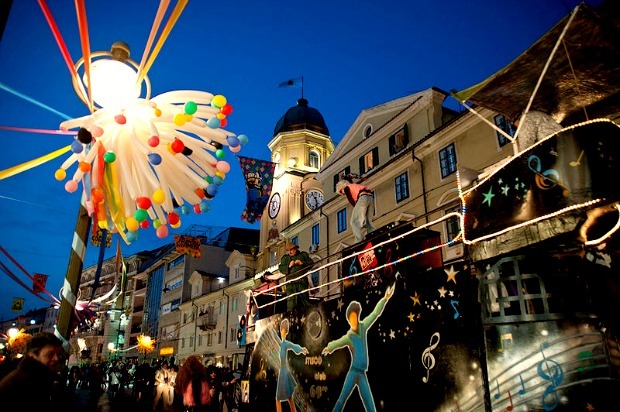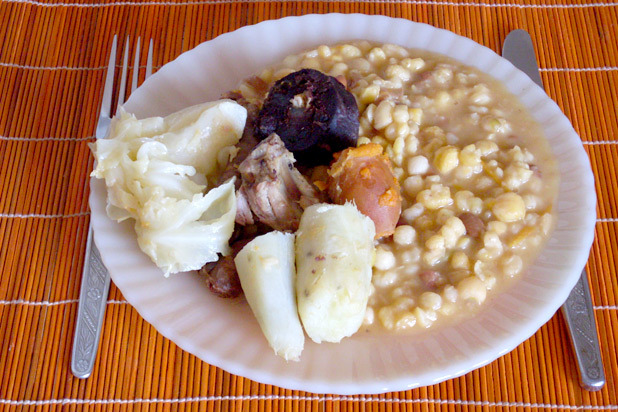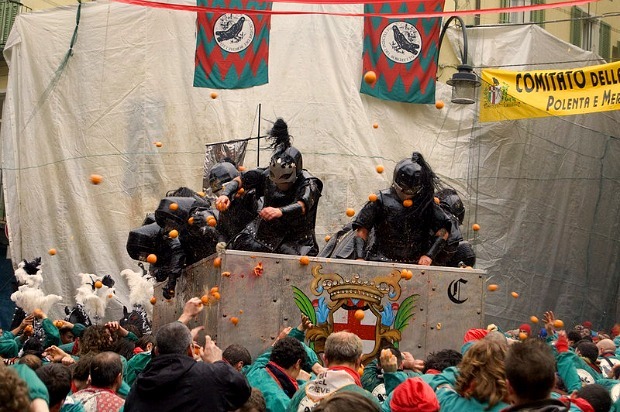Carnival Around The World Slideshow
India
Indian Carnival takes place almost exclusively in the southeastern state of Goa, which was ruled by Portugal from the 1500s until about 50 years ago. The capital city of Panaji is where the main festivities are held, starting with the ritualistic "occupation" of the state at the hands of "King Momo," and lasting for three days and nights. Classic Goan dishes like fish curry rice, potato chops (filled with minced beef), and the Raos omelet (dipped in spicy coconut curry) are on offer with crisp, cold, local beers to wash it all down.
Germany
One of the most unique (and seemingly most fun) versions of Carnival happens each year in the German cultural epicenter of Cologne. The women of the city participate in a ritual known as "Old Women's Day," or "Weiberfastnacht," in which they roam wildly through the streets kissing any man they choose, but not before cutting off their tie. Sold all throughout the streets are fried, puffy fastnacht doughnuts covered in powdered sugar.
Croatia
The Rijeka Carnival in Croatia technically begins in mid-January and lasts until Feb. 19, when there is the "Burning of the Pust" (an effigy representing the hardships of the year past). A typical food to prepare and eat for Croatian Carnival is a fritule, which are small pastries similar to doughnuts baked with some type of brandy in them.
Cape Verde
All nine inhabited islands of this archipelago off the coast of West Africa celebrate "Carnaval," but the city of Mindelo takes the cake as one the most colorful and lively celebrations in the entire continent. This is in part due to the fierce competition over such annual prizes as Best Group, King of Carnaval, Queen of Carnaval, and Best Parade Car. Considered the national dish of Cape Verde, cachupa (pictured), made with hominy, beans, fish, or meat and often with a fried egg on top, is in high demand during Carnaval.
Denmark
True wish fulfillment for the sadistic boys and girls of Denmark, the festival of Fastelavn occurs on the Sunday or Monday before Ash Wednesday, and involves children using a fastelavnsris, or a switch, to hit their sleeping parents in order to wake them up for the day of Halloween-like rituals and fastelavnbollers, or cream-filled pastries.
Portugal
In a cyclical twist of irony, even though Portugal is largely responsible for the better-known Brazilian Carnival, it has started to borrow some of the styles and traditions from Rio (in its former colony) for its own bash. Still, the Torres Vedras Carnival north of Lisbon is regarded as "the most Portuguese Carnival in Portugal," and often involves decorated streetcars that satirize pop culture and politics. The regional cousin of the iconic pasteis de nata from Lisbon is the pasteis de feijão, an almond-based pastry served throughout the area.
Trinidad and Tobago
Just researching the Carnivals of Trinidad and Tobago makes you exhausted. The month-long festival is really the culmination of a year's worth of preparation, all coming to a head on the Monday and Tuesday before Ash Wednesday, when revelers participate in an enormous Calypso "Steel Pan" competition. Only after days and days of parading do most locals retire to the beach for an Ash Wednesday cool-down party and a couple of roadside doubles (pictured).
Italy
Though the Carnival of Venice is the oldest and most famous of the Italian Carnivals (first recorded in the 11th century), the small city of Ivrea is host to the infamous Orange Battles, where hoards of people dressed in medieval garb take up arms of citrus against groups of helmeted "tyrants" travelling by carriage and representing the Holy Roman Emperor Frederick of Swabia. Oranges are thrown from every direction, and vin brulé wine is drunk by all.
Greece
Leave it to Greece to hold the strangest (and funniest) of Carnival celebrations, taking place in the community of Tyrnavos. There, they stage the annual Phallus Festival, which consists of the erection — pun intended — of phallic-like floats which are paraded through the streets so that women may touch or kiss them. The reward for this act of humiliation, of course, is a shot of potent alcohol.
Brazil
No, the "Greatest Show on Earth" is not the Ringling Brothers. It's Brazilian Carnival. Every year, more than 75,000 people crowd into Rio de Janeiro's "Sambadrome" to witness the many different samba schools and their four-night tournament of elaborate music, costume, and dance battles. The biggest parade, however, is the Galo da Madrugada in Pernambuco, where nearly 2 million people gather side-by-side — no room for schools — to dance and play their instruments en masse. Specialty foods, of course, are served on streets and in restaurants around Rio, like (of course) feijoada, various sweet and savory pastries, and bolinos de chuva (similar to doughnuts).









